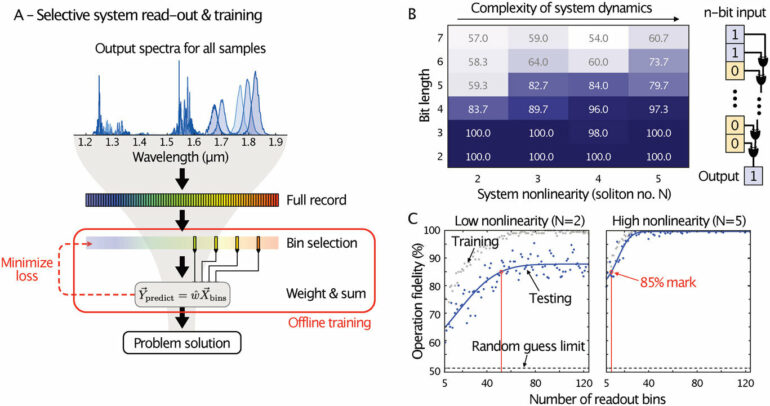by Lavinia Meier-Ewert, Leibniz-Institut für Photonische Technologien e. V.
Artificial intelligence is pivotal in advancing biotechnology and medical procedures, ranging from cancer diagnostics to the creation of new antibiotics. However, the ecological footprint of large-scale AI systems is substantial. For instance, training extensive language models like ChatGPT-3 requires several gigawatt-hours of energy—enough to power an average nuclear power plant at full capacity for several hours.
Prof. Mario Chemnitz and Dr. Bennet Fischer from Leibniz IPHT in Jena, in collaboration with their international team, have devised an innovative method to develop potentially energy-efficient computing systems that forego the need for extensive electronic infrastructure.
They harness the unique interactions of light waves within optical fibers to forge an advanced artificial learning system. Unlike traditional systems that rely on computer chips containing thousands of electronic components, their system uses a single optical fiber.
This fiber is capable of performing the tasks of various neural networks—at the speed of light. “We utilize a single optical fiber to mimic the computational power of numerous neural networks,” Mario Chemnitz, leader of the “Smart Photonics” junior research group at Leibniz IPHT, explains. “By leveraging the unique physical properties of light, this system will enable the rapid and efficient processing of vast amounts of data in the future.”
Delving into the mechanics reveals how information transmission occurs through the mixing of light frequencies: Data—whether pixel values from images or frequency components of an audio track—are encoded onto the color channels of ultrashort light pulses.
These pulses carry the information through the fiber, undergoing various combinations, amplifications, or attenuations. The emergence of new color combinations at the fiber’s output enables the prediction of data types or contexts. For example, specific color channels can indicate visible objects in images or signs of illness in a voice.
A prime example of machine learning is identifying different numbers from thousands of handwritten characters. Mario Chemnitz, Bennet Fischer, and their colleagues from the Institut National de la Recherche Scientifique (INRS) in Québec utilized their technique to encode images of handwritten digits onto light signals and classify them via the optical fiber.
The alteration in color composition at the fiber’s end forms a unique color spectrum—a “fingerprint” for each digit. Following training, the system can analyze and recognize new handwriting digits with significantly reduced energy consumption.
“In simpler terms, pixel values are converted into varying intensities of primary colors—more red or less blue, for instance,” Mario Chemnitz details. “Within the fiber, these primary colors blend to create the full spectrum of the rainbow. The shade of our mixed purple, for example, reveals much about the data processed by our system.”
The team has also successfully applied this method in a pilot study to diagnose COVID-19 infections using voice samples, achieving a detection rate that surpasses the best digital systems to date.
“We are the first to demonstrate that such a vibrant interplay of light waves in optical fibers can directly classify complex information without any additional intelligent software,” Mario Chemnitz states.
Since December 2023, Mario Chemnitz has held the position of Junior Professor of Intelligent Photonic Systems at Friedrich Schiller University Jena. Following his return from INRS in Canada in 2022, where he served as a postdoc, Chemnitz has been leading an international team at Leibniz IPHT in Jena. Their research focuses on exploring the potential of non-linear optics. Their goal is to develop computer-free intelligent sensor systems and microscopes, as well as techniques for green computing.
The paper is published in the journal Advanced Science.
More information:
Bennet Fischer et al, Neuromorphic Computing via Fission‐based Broadband Frequency Generation, Advanced Science (2023). DOI: 10.1002/advs.202303835
Provided by
Leibniz-Institut für Photonische Technologien e. V.
Citation:
Neural networks made of light: Research team develops AI system in optical fibers (2024, February 21)

